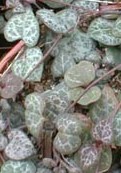 This tender evergreen perennial vine, also known as rosary plant, is native to South Africa, Zimbabwe and Swaziland where it grows in well-drained soil in some sun but is commonly grown as a houseplant in the United States because it tolerates neglect. The heart shaped leaves are .5 to .75 inches across, opposite, and marbled with silvery white on the upper side and dark purple on the underside. The purplish stems are very thin and grow in a tangled mass. They produce tubers at the leaf nodes producing a resemblance to a rosary. The unique flowers are waxy, one inch long, and appear in summer and fall. They have a bulbous base and a slender, pale purple tubular corolla with five dark purple petals fused at the tips forming a cage-like structure over the top. Hummingbirds will visit the flowers if the plant is grown outdoors. Plants are best grown in hanging containers or on pedestals to show off their trailing stems and attractive leaves. In zones 10 and 11 the plants can be grown outside all year but in cool areas they should be grown in a sunny window during the winter when they profit from a rest.
This tender evergreen perennial vine, also known as rosary plant, is native to South Africa, Zimbabwe and Swaziland where it grows in well-drained soil in some sun but is commonly grown as a houseplant in the United States because it tolerates neglect. The heart shaped leaves are .5 to .75 inches across, opposite, and marbled with silvery white on the upper side and dark purple on the underside. The purplish stems are very thin and grow in a tangled mass. They produce tubers at the leaf nodes producing a resemblance to a rosary. The unique flowers are waxy, one inch long, and appear in summer and fall. They have a bulbous base and a slender, pale purple tubular corolla with five dark purple petals fused at the tips forming a cage-like structure over the top. Hummingbirds will visit the flowers if the plant is grown outdoors. Plants are best grown in hanging containers or on pedestals to show off their trailing stems and attractive leaves. In zones 10 and 11 the plants can be grown outside all year but in cool areas they should be grown in a sunny window during the winter when they profit from a rest.
 Type: Evergreen trailing vine
Type: Evergreen trailing vine
Bloom: Light purple tubular flower with bulbous base and dark purple purple petals fused at their tips, in summer and fall
Size: 2-4’ length
Light: Bright light to part sun
Soil: Average, dry, well-drained; soil should dry out between watering
Hardiness: Zones 10=11; grown as a houseplant
Care: When moving to outdoors for summer, gradually increase the light to prevent scorching. Fertilize half strength once a month.
Pests and Diseases: Mealy-bugs
Propagation: Cuttings, tubers, seed
To buy Rosary Vine – 6″ Hanging Basket Ceropegia woodii from Amazon.com click here.

Flower photo from Wikipedia